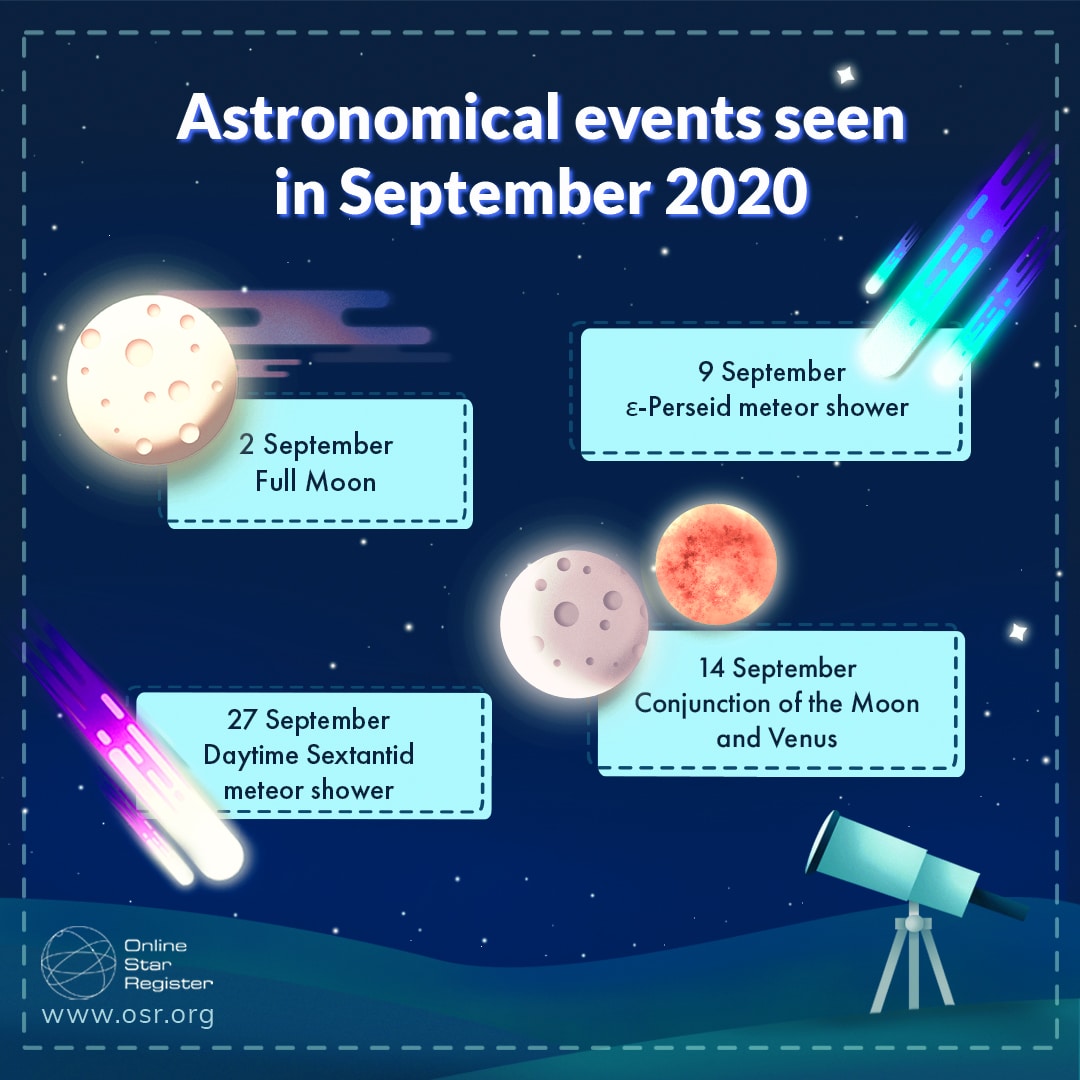The astronomical events of September 2020

September is a month with a lot of variety in the night sky! Come explore the astronomical events of September 2020 with us! Learn more about the Fruit Moon, the ε-Perseid meteor shower, the Conjunction of the Moon and Venus and the Sextantid meteor shower.
Let us guide you through the astronomical events of September 2020. We have handpicked four mesmerizing astronomical events, especially for you. And best of all, they are all be visible with the naked eye in both the northern and southern hemispheres! If you have binoculars or a telescope at your disposal, feel free to use them. Don’t forget to write down the dates of the events in your calendar so you won’t miss them!

Astronomical Event #1: The Fruit Moon
The Fruit Moon may sound very tasty, but is merely the name of the full Moon for the month of September! Sequences of full Moon are often assigned names based on the seasons in which they fall. Therefore, the full Moon of September is named the Fruit Moon.
A full Moon is visible because it lies almost directly opposite the Sun in the sky. This month the Fruit Moon will be visible on Wednesday the 2nd of September from the constellation Aquarius. Make sure to find a light-free area to be able to spot the constellation Aquarius since its stars are faint and can be relatively hard to see. Need help finding the constellation? Use the OSR Star Finder App!
The Fruit Moon will appear at its highest in the southern hemisphere, although both northern and southern hemispheres will be able to view the full Moon. At the start of the night the Moon rises in the East and at the end of the night the Moon sets in the West. You can use a compass if you have trouble finding it!
Astronomical Event #2: ε Perseid meteor shower
The Perseid meteor shower shows shooting stars across the galaxy. However, these are not shooting stars but meteors! A meteor shower happens because the Earth is passing through collections of debris. This space debris is left behind from comets and asteroids. Therefore, whenever the Earth passes the particular point in its orbit where it crosses the particular stream of material, a meteor shower is visible. These meteor shows can be annual since the Earth crosses the same points every year.
The September ε-Perseid meteor shower will be active from Saturday the 5th of September to Monday the 21st of September, but the best day to view the meteor shower is on Wednesday the 9th of September. The meteor shower will take place in the constellation Perseus, visible in the North.
To see the most meteors, make sure to view them from a place without light pollution. Additionally, you can look at a dark patch of sky which is around 30–40° away from the meteor showers’ source. This provides a distance from the radiant which causes you to see the most meteors!
Astronomical Event #3: Conjunction of the Moon and Venus
A conjunction is an event where two or more astronomical bodies share the same right ascension. So what does this mean? Actually, right ascension is simply the celestial equivalent of terrestrial longitude. Also known as the distance between East and West on Earth. As the Moon and Venus move along the ecliptic at different speeds, they pass each other from time to time. The planets are usually separated by no more than a few degrees when in conjunction.
On Monday the 14th of September you will be able to view the conjunction of the Moon and Venus. The Moon and Venus can both be found in the constellation Cancer. Cancer lies between Leo and Gemini. With the naked eye, the constellation Cancer may look more like a faint, upside-down Y.
While the Moon and Venus are sharing the same right ascension, they will still be too widely separated to fit within the view of a telescope. Nevertheless, it is still possible to see the conjunction with the naked eye or through a pair of binoculars!
Astronomical Event #4: Sextantid meteor shower
The Sextantid meteor shower is much like the Perseids meteor shower since it is an annual meteor shower. However, in contrast to the Perseids meteor shower, the Sextantid meteor shower is a daytime meteor shower. Therefore, the shower will not be visible at night but during the early hours of the morning.
You can find the Sextantid meteor shower in the constellation of Sextans. The constellation Sextans can be found between Hydra and Leo. Sextans lies in the southern sky, near the celestial equator and can therefore be seen from both hemispheres. The Sextans constellation may be hard to find, since the constellation covers a small region of the sky and is rather dim.
The Daytime Sextantid meteor shower will be active from the 9th of September to the 9th of October, but the highest amount of meteors will be visible around the 27th of September. The meteor shower will remain active in the constellation of Sextans for about two hours until dawn breaks.
Enjoy exploring the night sky!
We hope to have given you enough reason to go out exploring the galaxy with the astronomical events of September 2020! From full Moon to (daytime) meteor showers and the conjunction of the Moon and Venus – there’s enough to discover!
Want to stay in the loop on the upcoming astronomical events?
